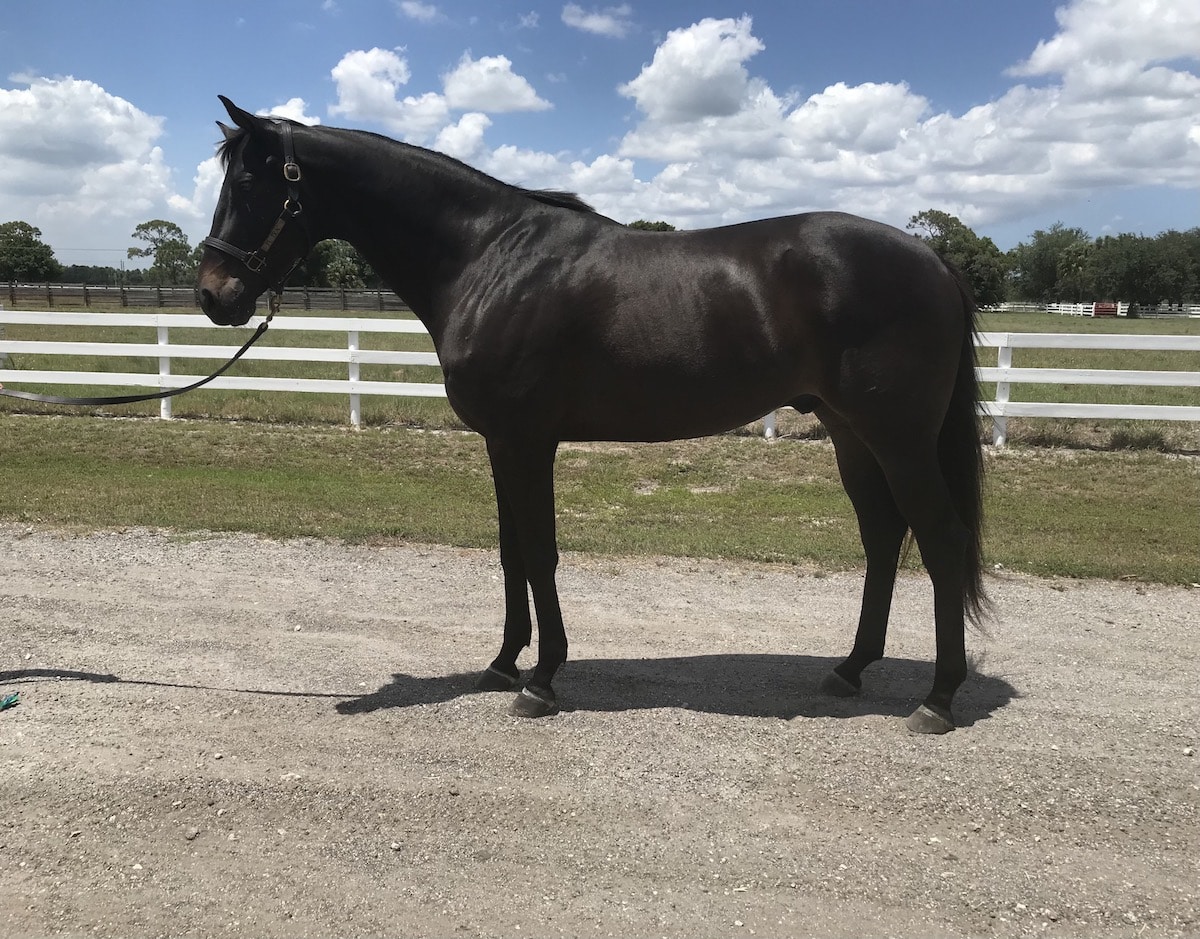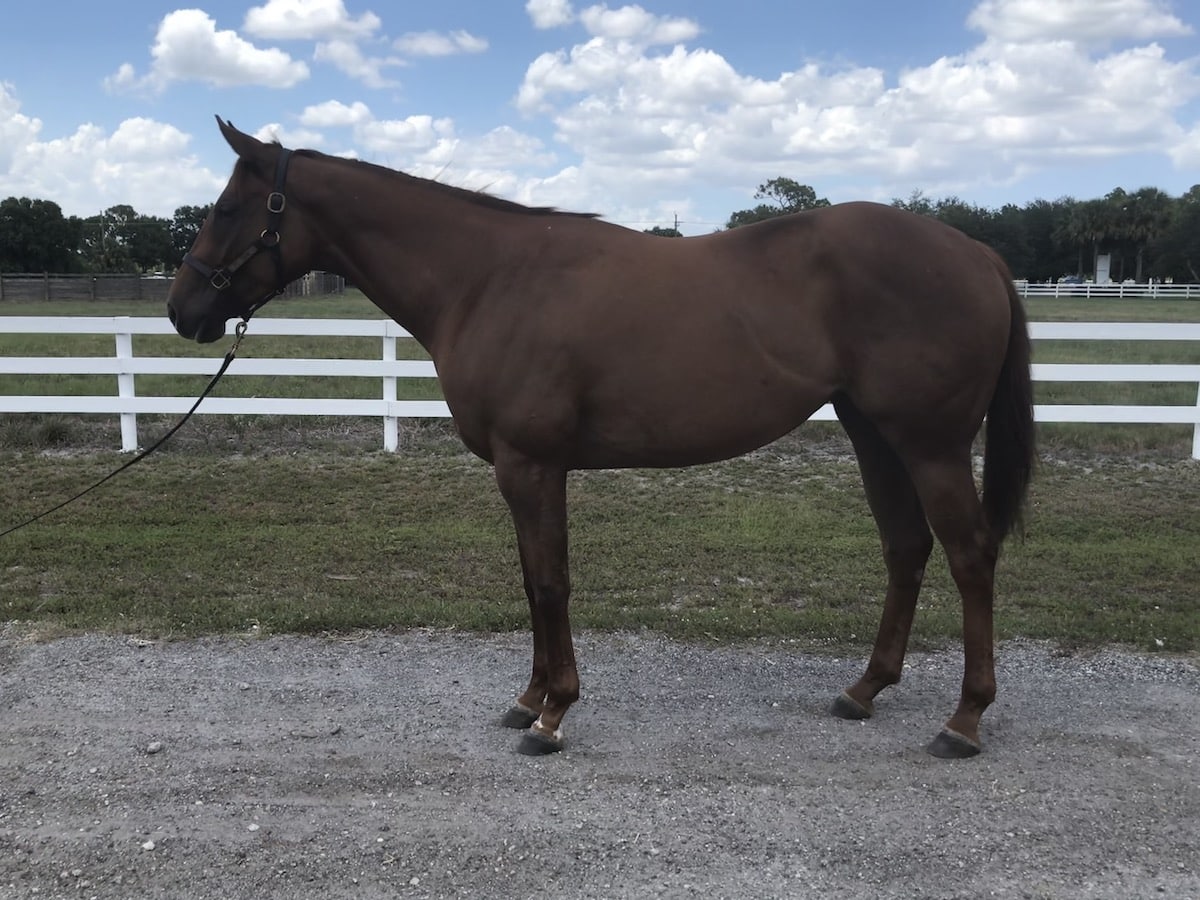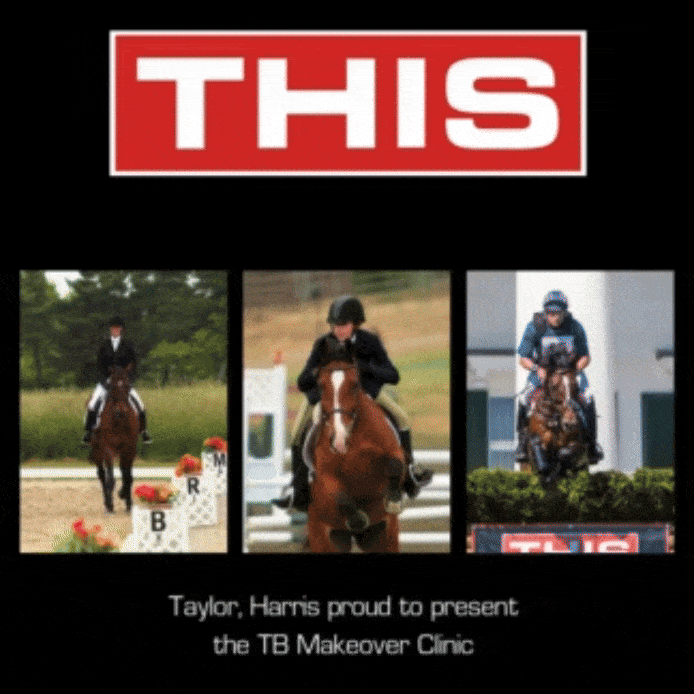Makeover trainers evaluate sport horse potential based on conformation shots
Social media and new smartphone apps have enabled potential OTTB owners to review a large number of retiring Thoroughbred racehorse listings at any time. Newcomers to the breed might find it challenging to consider a prospect right off the track and decide if it’s a match for their desired purpose.
In this column veteran Thoroughbred Makeover trainers — professionals, juniors and amateurs alike — share their thoughts about assessing and selecting prospects based only on conformation photos. We feature trainers from two disciplines in each issue.
Our Trainers
■ Liz Howell
Having tried a range of disciplines over her 15-year equestrian career, Howell fell in love with the sport of barrel racing. While she’s primarily focused on Paints, a love and respect for Thoroughbreds runs in her family; her mother worked at several tracks in New Jersey. Howell adopted her first Thoroughbred — Whiskey Terms — in 2018 from Horses Without Humans, where she was working at the time. She retrained him to a third-place finish at the 2019 Thoroughbred Makeover in Barrel Racing and earned Grand Champion in barrel racing at the Florida Thoroughbred Expo that same year.
■ Kate Samuels
Samuels has been riding since the age of 3 through what she describes as “trial and error over the rivers and across the fields.” This early exposure led her naturally to the sport of eventing. Her first mentor was a Swiss ex-cavalryman who offered her a job galloping horses at his training track when she was 13, which helped Samuels develop a natural love for Thoroughbreds. She placed fifth in Eventing and sixth in Show Jumping in 2018 with Turkomani, whom she continues to produce up the levels.
Choosing a Horse
Kate Samuels, an eventing trainer from Charlottesville, Virginia, sources nearly all her Thoroughbreds through her personal connections formed while galloping at the track, but she’s also found horses by spotting single photos or roundpen-work videos online, sometimes acquiring prospects sight-unseen. The common factor among them is Samuels asks their exercise riders, owners and, if possible, grooms, about the horses. “Grooms and riders are seriously untapped resources,” Samuels says.
Barrel racing trainer Liz Howell, who’s based in Bell, Florida, has also found personal and client horses online, from photos and videos, and prefers to see a longeing video, if possible, to get an idea about a horse’s movement and personality. “I much prefer to meet the horse in person,” she says. “I like to evaluate them under saddle and, then, if everything is going well from there, I’ll schedule a PPE (prepurchase exam).”
Howell is drawn to balanced conformation. “I know no individual is perfect, but overall balance is the biggest factor in my decision,” she says. If she’s looking for barrel prospects, she prefers horses on the smaller side — no taller than 15.2 hands, with a “big motor” or well-built hind end and heftier bone. “The racing background is not as important to me,” she adds. “I’m more concerned with personality: Is the horse friendly? Eager to learn? Willing? Easy to handle? These are all factors that make second career training a lot easier.”
Samuels, on the other hand, does seek information about the horse’s racing background. “I prefer a horse that’s done some racing, versus unraced or lightly raced,” she says. “I think a horse that has proven its soundness over several years of racing is more likely to be generally sound for a second career.”
Beyond race record, Samuels looks for short-coupled horses with self-carriage and fluid movement. Conformationally, she likes a horse that looks like his pieces fit together seamlessly. “Successful horses come in all shapes and sizes, and you’d only have to look at jog photos from a CCI***** to know that,” she says.
Meet the Prospects
Our model horses come from Florida Thoroughbred Retirement and Adoptive Care (FL TRAC), in Indiantown. Formed in 2009 by a group of volunteers who recognized the need for South-Florida-based Thoroughbred aftercare and spearheaded by the Florida Horsemen’s Benevolent and Protective Association (FHBPA), Calder Race Course, Gulfstream Park and professional jockeys, FL TRAC is now a 501(c)(3) nonprofit dedicated to helping Thoroughbreds find second careers and enjoy high quality of life.
Horses come to FL TRAC exclusively from South Florida racing connections and are donated to the program. Horses are let down, undergo any needed rehabilitation and start in FL TRAC’s retraining program. Adoption screening ensures horses are placed in appropriate homes, from first-time horse owners all the way to Olympic-level professionals.
Gulfstream Park, Florida HBPA, Thoroughbred Aftercare Alliance grants and private donors fund FL TRAC. To date, more than 500 horses have entered the program. Some horses with unique needs live out their retirement at FL TRAC’s facility.
While these three horses might no longer be available for adoption when this issue hits your mailbox, FL TRAC has plenty of prospects looking for their next partners.

1: Wisely (Candy Ride [ARG] — Hard Ten Hopping, Rock Hard Ten) Courtesy FL TRAC

2: Ginebra (Point Determined — Lariat, Carson City) Courtesy FL TRAC

3: Michael Wonderful (Liaison — It’s Heidi’s Dance, Green Dancer) Courtesy FL TRAC
Howell’s Picks
Horse 3 I would definitely consider all three of these as barrel horse prospects — but I might place them differently with an in-person inspection once I felt them under saddle. Out of these individuals I like this horse the most. He looks well-balanced, and his heavier build gives him a Western performance horse look. I like the shorter neck, accompanied by a naturally level head stance. I love the big, deep shoulder. He does have a longer back than I would prefer, but it works with the rest of his body. I’m sure this would lengthen his stride rather than hinder his performance as a barrel horse.
Horse 2 This horse also has a Western performance look and heavier bone. Her back is more of the length I would look for in a barrel prospect. She does look to be on the shorter side, which is my personal preference. If I had to fault her, she’s a little bit downhill, which might sit the rider forward going into the turn. However, she is well-proportioned from the front to the rear, with nice overall muscling and topline.
Horse 1 It was a tough choice between these last two horses. As much as I like this horse, his build and flash make me think he might be better suited for a different discipline. His back looks to be the shortest of the three, but his size and lighter bone make me feel like he might be an eventing prospect. This horse has a very attractive appearance, and the way he holds his neck gives the impression that he would have a lot of natural self-carriage. He is also built a little uphill, which could aid him in his ability to rate the barrel — this alone could assist in making him an excellent barrel horse.
Samuels’ Picks
Horse 1 I love the look of this dark bay beauty. He fits my personal style of a short-coupled horse, which I find is usually easier to balance and train for most riders in the arena. His legs are lovely and straight, and he also looks to have decent hoof quality with a good heel. I like how his neck comes out of his shoulder, suggesting that connecting into a frame should come quite easily to him. His hip angle and well-formed hindquarters should serve him well to push and collect over jumps or on the flat. He has a beautiful expression and a soft eye, and he seems relaxed and happy in the company of people. I’d buy him if I were looking for my next eventing prospect!
Horse 2 This is a horse I would pick out for an adult amateur or junior rider in my program. She’s in beautiful condition, which says a lot about her health and happiness. I feel from her relaxed but attentive expression she has a “cool dude” personality. She’s a bit more downhill than the first horse, but for most riders this shouldn’t be an issue, and the muscling along her topline and neck suggests she is fully capable of traveling correctly rather than dragging herself along on the forehand. She has a good strong shoulder, correct legs and a powerful hind end. Her smaller stature and compact nature shouldn’t be overlooked; she looks naturally well-balanced.
Horse 3 This lad has some big bones! Looking at just frame, legs and feet, you can tell he’s a solid man. He likely needs a bit more time to fill out and muscle up through some long, slow miles. He has a huge shoulder and great depth, which should benefit him when he has the strength to carry himself. His neck might be a touch too short to match the rest of his body, but a shorter neck is always easier to manage than an incredibly long one. He’s a little longer in the back than the other two, and he does need more muscle development in the lower back, but his hindquarters are strong. He has a sweet, loving expression and seems like a suitable prospect for a little bit of everything.
This article was originally published in the Summer 2021 issue of Off-Track Thoroughbred Magazine, the only publication dedicated to the Thoroughbred ex-racehorse in second careers. Want four information-packed issues a year delivered to your door or your favorite digital device? Subscribe now!

